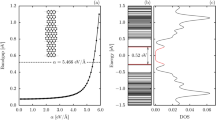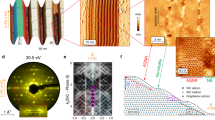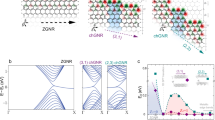Abstract
Many proposed applications of graphene require the ability to tune its electronic structure at the nanoscale1,2. Although charge transfer3 and field-effect doping4 can be applied to manipulate charge carrier concentrations, using them to achieve nanoscale control remains a challenge. An alternative approach is ‘self-doping’5, in which extended defects are introduced into the graphene lattice. The controlled engineering of these defects represents a viable approach to creation and nanoscale control of one-dimensional charge distributions with widths of several atoms6. However, the only experimentally realized extended defects so far have been the edges of graphene nanoribbons7,8,9,10, which show dangling bonds that make them chemically unstable11,12,13. Here, we report the realization of a one-dimensional topological defect in graphene, containing octagonal and pentagonal sp2-hybridized carbon rings embedded in a perfect graphene sheet. By doping the surrounding graphene lattice, the defect acts as a quasi-one-dimensional metallic wire. Such wires may form building blocks for atomic-scale, all-carbon electronics.
This is a preview of subscription content, access via your institution
Access options
Subscribe to this journal
Receive 12 print issues and online access
$259.00 per year
only $21.58 per issue
Buy this article
- Purchase on Springer Link
- Instant access to full article PDF
Prices may be subject to local taxes which are calculated during checkout




Similar content being viewed by others
References
Geim, A. K. & Novoselov, K. S. The rise of graphene. Nature Mater. 6, 183–191 (2007).
Geim, A. K. Graphene: status and prospects. Science 324, 1530–1534 (2009).
Jung, N. et al. Charge transfer chemical doping of few layer graphenes: charge distribution and band gap formation. Nano Lett. 9, 4133–4137 (2009).
Zhang, Y. et al. Direct observation of a widely tunable bandgap in bilayer graphene. Nature 459, 820–823 (2009).
Castro Neto, A. H., Guinea, F., Peres, N. M. R., Novoselov, K. S. & Geim, A. K. The electronic properties of graphene. Rev. Mod. Phys. 81, 109–162 (2009).
Ritter, K. A. & Lyding, J. W. The influence of edge structure on the electronic properties of graphene quantum dots and nanoribbons. Nature Mater. 8, 235–242 (2009).
Nakada, K., Fujita, M., Dresselhaus, G. & Dresselhaus, M. S. Edge state in graphene ribbons: nanometer size effect and edge shape dependence. Phys. Rev. B 54, 17954–17961 (1996).
Girit, C. O. et al. Graphene at the edge: stability and dynamics. Science 323, 1705–1708 (2009).
Li, X. L., Wang, X. R., Zhang, L., Lee, S. & Dai, H. Chemically derived, ultrasmooth graphene nanoribbon semiconductors. Science 319, 1229–1232 (2008).
Kosynkin, D. V. et al. Longitudinal unzipping of carbon nanotubes to form graphene nanoribbons. Nature 458, 872–876 (2009).
Wang, X. et al. N-doping of graphene through electrothermal reactions with ammonia. Science 324, 768–771 (2009).
Koskinen, P., Malola, S. & Häkkinen, H. Self-passivating edge reconstructions of graphene. Phys. Rev. Lett. 101, 115502 (2008).
Koskinen, P., Malola, S. & Häkkinen, H. Evidence for graphene edges beyond zigzag and armchair. Phys. Rev. B 80, 073401 (2009).
Hashimoto, A., Suenaga, K., Gloter, A., Urita, K. & Iijima, S. Direct evidence for atomic defects in graphene layers. Nature 430, 870–873 (2004).
Lusk, M. T. & Carr, L. D. Nanoengineering defect structures on graphene. Phys. Rev. Lett. 100, 175503 (2008).
Meyer, J. C. et al. direct imaging of lattice atoms and topological defects in graphene membranes. Nano Lett. 8, 3582–3586 (2008).
Botello-Méndez, A. R. et al. Spin polarized conductance in hybrid graphene nanoribbons using 5–7 defects. ACS Nano 3, 3606–3612 (2009).
Okada, S., Nakada, K., Kuwabara, K., Daigoku, K. & Kawai, T. Ferromagnetic spin ordering on carbon nanotubes with topological line defects. Phys. Rev. B 74, 121412 (2006).
Simonis, P. et al. STM study of a grain boundary in graphite. Surf. Sci. 511, 319–322 (2002).
Gamo, Y., Nagashima, A., Wakabayashi, M., Terai, M. & Oshima, C. Atomic structure of monolayer graphite formed on Ni(111). Surf. Sci. 374, 61–64 (1997).
Terrones, H. et al. New metallic allotropes of planar and tubular carbon. Phys. Rev. Lett. 84, 1716–1719 (2000).
White, C. T. & Mintmire, J. Fundamental properties of single-wall carbon nanotubes. J. Phys. Chem. B 109, 52–65 (2005).
Charlier, J.-C., Blasé, X. & Roche, S. Electronic and transport properties of nanotubes. Rev. Mod. Phys. 79, 677–732 (2007).
Kim, K. S. et al. Large-scale pattern growth of graphene films for stretchable transparent electrodes. Nature 457, 706–710 (2009).
Haick, H. & Cahen, D. Making contact: connecting molecules electrically to the macroscopic world. Prog. Surf. Sci. 83, 217–261 (2008).
Bunch, J. S. et al. Impermeable atomic membranes from graphene sheets. Nano Lett. 8, 2458–2462 (2008).
Nagashima, A., Tejima, N. & Oshima, C. Electronic states of the pristine and alkali-metal-intercalated monolayer graphite/Ni(111) systems. Phys. Rev. B 50, 17487–17495 (1994).
Rosei, R. et al. Structure of graphitic carbon on Ni(111)—a surface extended-energy-loss fine-structure study. Phys. Rev. B 28, 1161–1164 (1983).
Kresse, G. & Furthmüller, J. Efficient iterative schemes for ab initio total-energy calculations using a plane-wave basis set. Phys. Rev. B 54, 11169–11186 (1996).
Khomyakov, P. A. et al. First-principles study of the interaction and charge transfer between graphene and metals. Phys. Rev. B 79, 195425 (2009).
Acknowledgements
This research was supported by the National Science Foundation (NSF) and the Office of Basic Energy Science, US Department of Energy. Calculations were performed using NSF TeraGrid facilities, USF Research Computing Cluster, and the computational facilities of Materials Simulation Laboratory at the University of South Florida (funded by ARO DURIP).
Author information
Authors and Affiliations
Contributions
J.L. conducted and analysed the experiments. Y.L. and P.B. performed and analysed the DFT calculations. I.I.O. directed the computational studies and contributed to writing the manuscript. M.B. directed the research and wrote the manuscript. All authors edited and commented on the manuscript.
Corresponding author
Ethics declarations
Competing interests
The authors declare no competing financial interests.
Supplementary information
Supplementary information
Supplementary information (PDF 467 kb)
Rights and permissions
About this article
Cite this article
Lahiri, J., Lin, Y., Bozkurt, P. et al. An extended defect in graphene as a metallic wire. Nature Nanotech 5, 326–329 (2010). https://doi.org/10.1038/nnano.2010.53
Received:
Accepted:
Published:
Issue Date:
DOI: https://doi.org/10.1038/nnano.2010.53
This article is cited by
-
Giant intrinsic photovoltaic effect in one-dimensional van der Waals grain boundaries
Nature Communications (2024)
-
Thermoelectric properties of armchair graphene nanoribbons: importance of quantum confinement
Journal of Nanoparticle Research (2024)
-
Effect of Line Defects on the Band Structures, Local Density of States, and the Landau Levels for Armchair Graphene Nanoribbons in the Quantum Hall Effect Regime
Journal of Electronic Materials (2024)
-
Imperfection-enabled memristive switching in van der Waals materials
Nature Electronics (2023)
-
Evidence for intrinsic defects and nanopores as hotspots in 2D PdSe2 dendrites for plasmon-free SERS substrate with a high enhancement factor
npj 2D Materials and Applications (2023)



